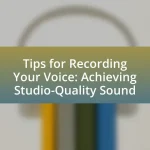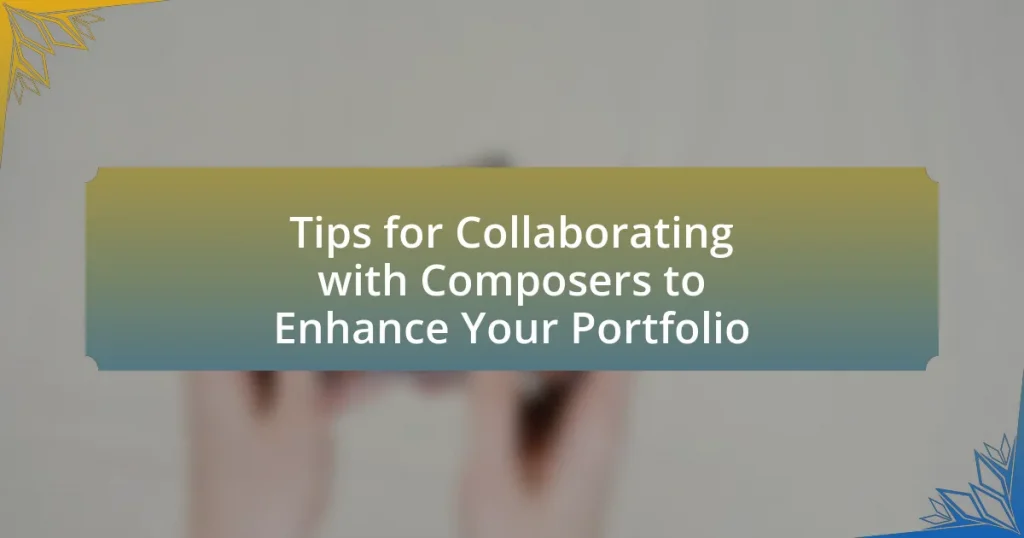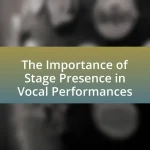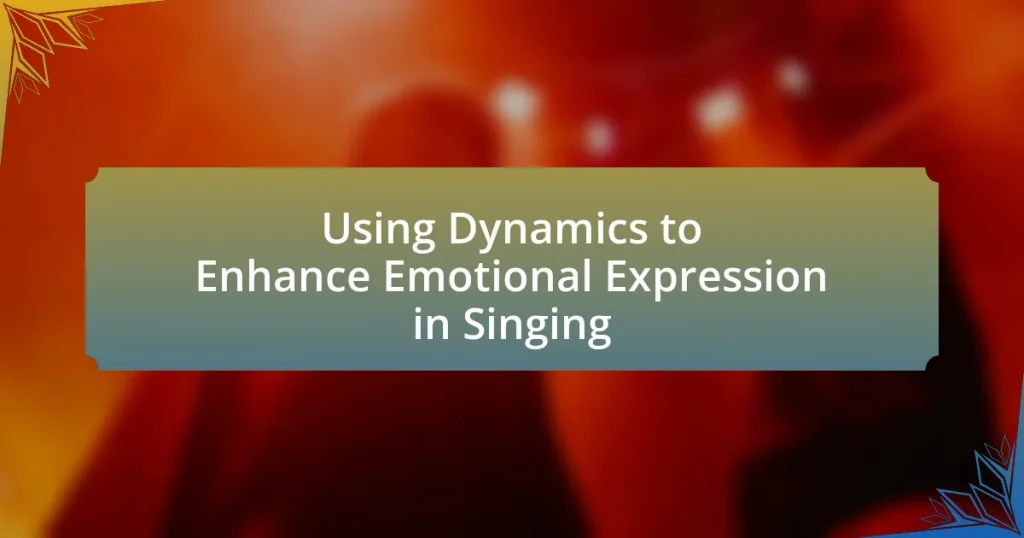The article focuses on effective strategies for collaborating with composers to enhance artistic portfolios. Key aspects include establishing clear communication, defining project goals, and showcasing diverse musical styles to attract a broader audience. It emphasizes the importance of understanding musical genres, providing and receiving constructive feedback, and utilizing appropriate communication tools. Additionally, the article outlines best practices for identifying suitable composers, managing creative differences, and maintaining long-term relationships, ultimately highlighting how these collaborations can lead to increased visibility and opportunities in the music industry.
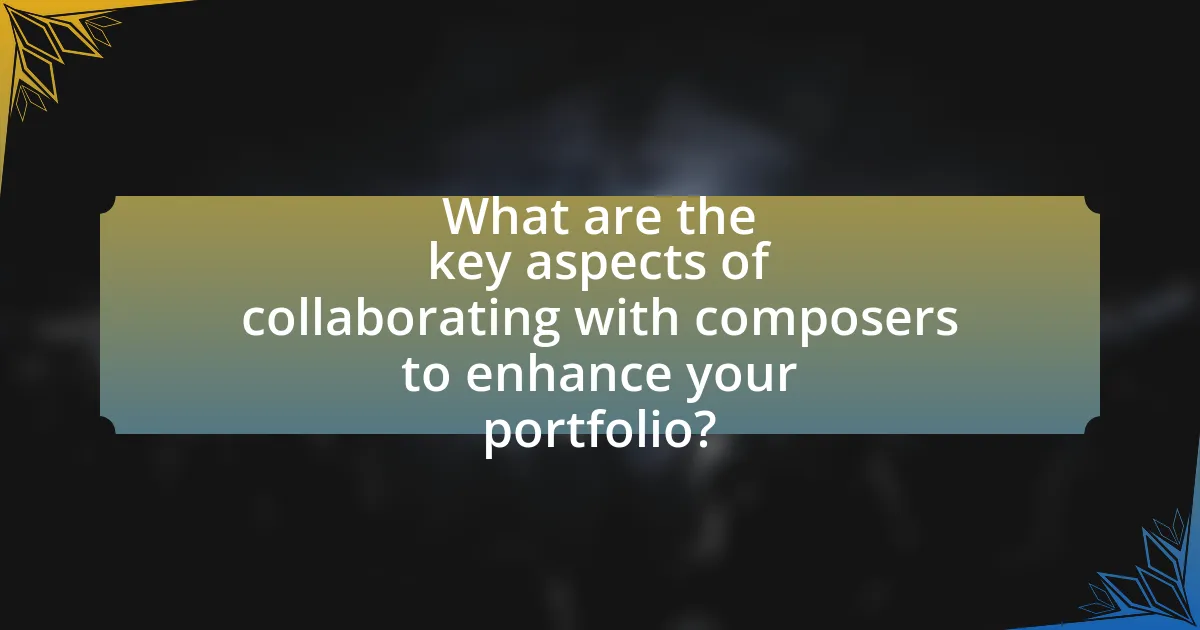
What are the key aspects of collaborating with composers to enhance your portfolio?
Collaborating with composers to enhance your portfolio involves establishing clear communication, defining project goals, and showcasing diverse styles. Clear communication ensures that both parties understand expectations and creative visions, which is crucial for a successful partnership. Defining project goals allows for focused collaboration, ensuring that the final product aligns with both the composer’s and your artistic objectives. Showcasing diverse styles in your portfolio demonstrates versatility and attracts a broader audience, making your work more appealing to potential clients. These aspects are essential for creating impactful collaborations that elevate your artistic presence.
How can effective communication improve collaboration with composers?
Effective communication enhances collaboration with composers by ensuring clarity in artistic vision and expectations. When collaborators articulate their ideas, preferences, and feedback clearly, it minimizes misunderstandings and aligns both parties towards a common goal. Research indicates that projects with open lines of communication experience a 25% increase in overall satisfaction and productivity, as reported in the “Project Management Journal.” This demonstrates that effective communication not only fosters a positive working relationship but also leads to more successful and cohesive musical outcomes.
What communication tools are best for collaborating with composers?
The best communication tools for collaborating with composers include platforms like Slack, Zoom, and Google Drive. Slack facilitates real-time messaging and file sharing, making it easy for composers and collaborators to discuss ideas and share materials instantly. Zoom allows for face-to-face meetings, which can enhance understanding and creativity during discussions. Google Drive provides a centralized location for storing and sharing documents, scores, and audio files, ensuring that all collaborators have access to the latest versions of their work. These tools are widely used in the music industry, as they streamline communication and improve collaboration efficiency.
How can you establish clear expectations with composers?
To establish clear expectations with composers, communicate specific project goals, timelines, and deliverables upfront. This clarity ensures that both parties understand the scope of work and deadlines, reducing the likelihood of misunderstandings. For instance, providing a detailed brief that outlines the desired style, instrumentation, and any reference tracks can guide the composer effectively. Additionally, regular check-ins throughout the project can help maintain alignment and address any emerging questions or concerns, fostering a collaborative environment.
What role does understanding musical styles play in collaboration?
Understanding musical styles is crucial in collaboration as it enables artists to effectively communicate and blend their creative ideas. When collaborators are familiar with various musical genres, they can draw from a wider palette of influences, leading to innovative and cohesive compositions. For instance, a study by the Journal of Music Theory indicates that cross-genre collaborations often yield unique soundscapes that resonate with diverse audiences, enhancing the overall impact of the work. This knowledge fosters mutual respect and understanding, allowing collaborators to navigate differences in artistic vision and achieve a harmonious outcome.
How can you identify the right composer for your project?
To identify the right composer for your project, assess their previous work and style to ensure alignment with your project’s vision. Review portfolios and listen to samples that showcase their versatility and expertise in the genre relevant to your project. Additionally, consider their experience with similar projects, as composers who have successfully worked in your specific area are more likely to understand your needs and deliver effectively. For instance, a composer with a strong background in film scoring may be more suitable for a cinematic project than one focused on commercial jingles.
What are the different musical genres and their impact on collaboration?
Different musical genres significantly influence collaboration by shaping the creative processes, communication styles, and outcomes of projects. For instance, genres like jazz emphasize improvisation and collective creativity, fostering a collaborative environment where musicians build on each other’s ideas in real-time. In contrast, genres such as classical music often involve more structured arrangements and defined roles, which can lead to a more hierarchical collaboration but also ensure clarity in the creative vision. Additionally, genres like hip-hop encourage collaboration through sampling and remixing, allowing artists to reinterpret existing works and create new expressions together. These genre-specific characteristics impact how artists interact, share ideas, and ultimately produce music, demonstrating that the genre can dictate the nature and effectiveness of collaborative efforts.
Why is feedback important in the collaboration process?
Feedback is important in the collaboration process because it fosters improvement and alignment among team members. When collaborators provide constructive feedback, it helps identify strengths and weaknesses in the work, ensuring that the final output meets the collective vision. Research indicates that teams that engage in regular feedback loops are 25% more productive, as they can quickly address issues and refine their approach. This continuous exchange of insights not only enhances individual contributions but also strengthens the overall collaboration, leading to higher quality outcomes.
How can you provide constructive feedback to composers?
To provide constructive feedback to composers, focus on specific elements of their work, such as melody, harmony, and arrangement. Begin by acknowledging strengths in their composition, which fosters a positive environment. Then, offer clear, actionable suggestions for improvement, such as recommending adjustments to dynamics or instrumentation. For instance, if a melody feels repetitive, suggest introducing variation to enhance interest. Research indicates that specific feedback leads to better outcomes; a study published in the Journal of Music Education found that targeted feedback significantly improved students’ compositional skills. This approach not only aids the composer in refining their work but also strengthens collaborative relationships.
What are the best practices for receiving feedback from composers?
The best practices for receiving feedback from composers include creating a structured environment for discussion, actively listening to their insights, and asking specific questions to clarify their feedback. Establishing a structured environment, such as scheduled meetings or feedback sessions, allows composers to prepare their thoughts and ensures that the feedback process is focused and productive. Actively listening demonstrates respect for their expertise and encourages open communication, fostering a collaborative atmosphere. Asking specific questions, such as inquiring about particular sections of a composition or the emotional impact of certain elements, helps to clarify their feedback and provides actionable insights. These practices enhance the collaboration process and lead to a more refined final product.
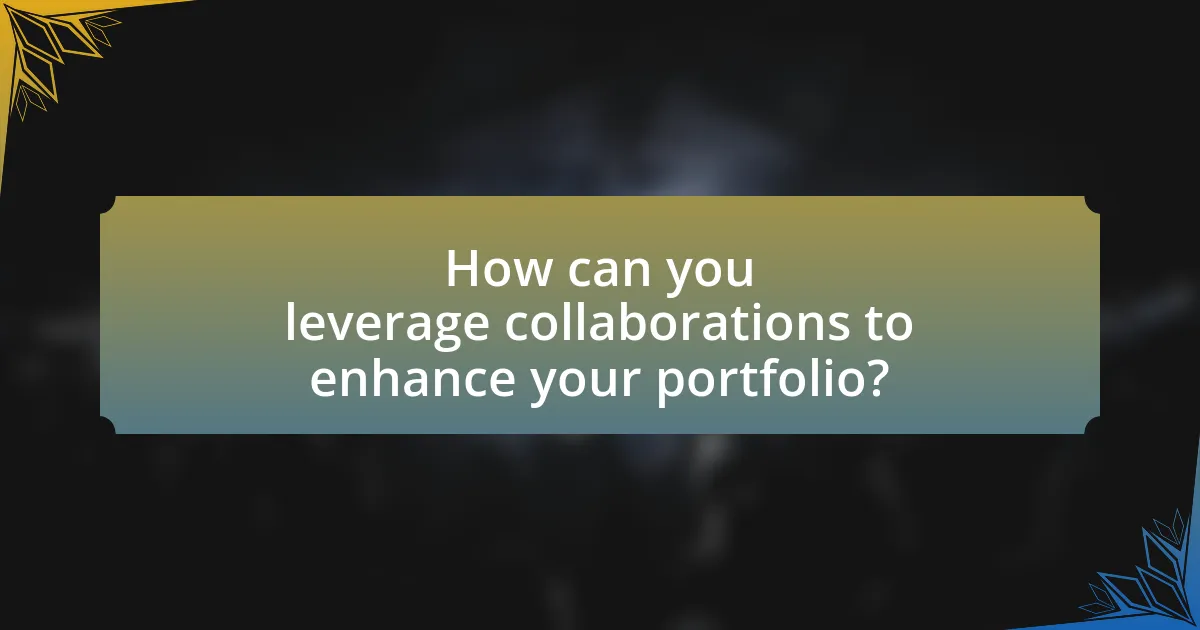
How can you leverage collaborations to enhance your portfolio?
Collaborations can enhance your portfolio by diversifying your skill set and showcasing a broader range of work. Engaging with composers allows you to incorporate unique musical styles and techniques into your projects, which can attract a wider audience. For instance, a study by the National Endowment for the Arts found that collaborative projects often lead to increased visibility and opportunities for artists, as they tap into each other’s networks. By working together, you not only gain access to new resources and ideas but also create a more compelling portfolio that reflects a collaborative spirit and innovation.
What types of projects can benefit from composer collaborations?
Projects that can benefit from composer collaborations include film scores, video game soundtracks, theatrical productions, and multimedia art installations. These projects often require specialized musical expertise to enhance storytelling, evoke emotions, and create immersive experiences. For instance, film scores are essential for setting the tone and atmosphere of a movie, while video game soundtracks can significantly impact player engagement and immersion. Collaborating with composers allows creators to leverage unique musical styles and techniques, ultimately enriching the overall quality and appeal of their projects.
How can you showcase collaborative projects in your portfolio?
To showcase collaborative projects in your portfolio, include detailed case studies that highlight your role, contributions, and the outcomes of the projects. Each case study should clearly outline the project goals, your specific responsibilities, and the collaborative process, demonstrating how teamwork led to successful results. For instance, if you worked on a music composition project with a composer, describe the creative process, the tools used, and any measurable impact, such as audience engagement or critical acclaim. This approach not only illustrates your collaborative skills but also provides concrete evidence of your contributions and the project’s success.
What are the advantages of including diverse musical styles in your portfolio?
Including diverse musical styles in your portfolio enhances versatility and broadens appeal to a wider audience. This diversity allows musicians to showcase adaptability, which is increasingly valued in the music industry, as it can lead to more collaboration opportunities and increased marketability. Research indicates that artists who incorporate various genres often attract a larger fan base, as they can connect with different listener demographics. For instance, a study by the University of Southern California found that musicians with eclectic styles are more likely to receive attention from record labels and streaming platforms, demonstrating the tangible benefits of a diverse portfolio.
How can networking with composers expand your opportunities?
Networking with composers can significantly expand your opportunities by providing access to collaborative projects, industry insights, and professional connections. Engaging with composers allows individuals to participate in diverse musical endeavors, which can enhance their portfolios and showcase their versatility. For instance, collaborations can lead to exposure in various genres, increasing visibility in the music industry. Additionally, composers often have established networks that can introduce you to other professionals, such as producers and directors, thereby opening doors to new projects and career advancements. Studies indicate that networking is a crucial factor in career development, with 70% of jobs being found through personal connections, highlighting the importance of building relationships within the music community.
What strategies can you use to connect with composers in your field?
To connect with composers in your field, actively participate in industry events such as workshops, conferences, and networking meetups. Engaging in these events allows you to meet composers face-to-face, fostering relationships through shared interests and professional goals. Additionally, utilizing social media platforms like LinkedIn and Twitter can help you follow and interact with composers, sharing insights and showcasing your work to attract their attention. Research indicates that personal connections made through direct interaction significantly enhance collaboration opportunities, as highlighted in studies on professional networking dynamics.
How can attending music events enhance your networking efforts?
Attending music events can significantly enhance your networking efforts by providing direct access to industry professionals and like-minded individuals. These events create an environment conducive to building relationships, as attendees often share common interests and goals related to music. For instance, a study by Eventbrite found that 78% of event attendees believe that networking is a key benefit of attending live events, highlighting the importance of face-to-face interactions in establishing professional connections. Engaging in conversations during these events can lead to collaborations, mentorship opportunities, and increased visibility within the music community.
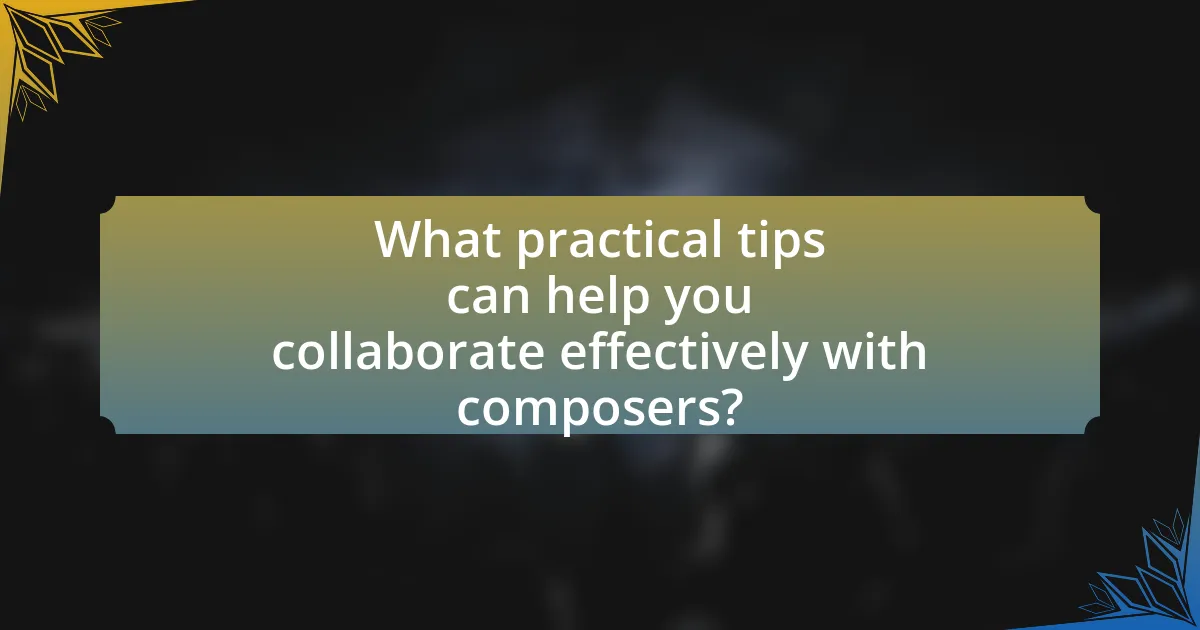
What practical tips can help you collaborate effectively with composers?
To collaborate effectively with composers, establish clear communication from the outset. This involves discussing project goals, timelines, and creative visions to ensure alignment. Regular check-ins throughout the collaboration process can help address any issues promptly and keep the project on track. Additionally, providing constructive feedback and being open to the composer’s ideas fosters a positive working relationship. Research indicates that successful collaborations often stem from mutual respect and understanding, which enhances creativity and productivity.
How can you prepare for a successful collaboration with a composer?
To prepare for a successful collaboration with a composer, clearly define your project goals and communicate them effectively. Establishing a shared vision ensures both parties understand the desired outcome, which is crucial for alignment. Researching the composer’s previous work can provide insights into their style and strengths, allowing you to tailor your collaboration approach. Additionally, setting a timeline with milestones helps manage expectations and keeps the project on track. Effective communication throughout the process fosters a positive working relationship, which is essential for creative collaboration.
What are the essential elements to include in a collaboration agreement?
The essential elements to include in a collaboration agreement are the scope of work, roles and responsibilities, compensation details, intellectual property rights, confidentiality clauses, and dispute resolution procedures. The scope of work defines the specific tasks and deliverables expected from each party, ensuring clarity in the collaboration. Roles and responsibilities outline who is accountable for what, preventing overlaps and misunderstandings. Compensation details specify how and when payments will be made, which is crucial for financial transparency. Intellectual property rights clarify ownership of the created work, protecting both parties’ interests. Confidentiality clauses safeguard sensitive information shared during the collaboration. Finally, dispute resolution procedures provide a framework for addressing conflicts, promoting a smoother collaboration process. These elements are critical for establishing a clear and effective collaboration framework.
How can you set realistic timelines for collaborative projects?
To set realistic timelines for collaborative projects, begin by assessing the scope and complexity of the project, which involves breaking down tasks into manageable components. This approach allows for a clearer understanding of the time required for each task. Additionally, involve all collaborators in the timeline-setting process to ensure that everyone’s availability and workload are considered, which fosters accountability and commitment. Research indicates that projects with clearly defined timelines and collaborative input are 30% more likely to meet deadlines, as highlighted in a study by the Project Management Institute. By regularly reviewing progress and adjusting timelines as necessary, teams can maintain flexibility and adapt to unforeseen challenges, ensuring that the project stays on track.
What common challenges might arise during collaboration, and how can you overcome them?
Common challenges during collaboration include communication breakdowns, differing creative visions, and time management issues. To overcome communication breakdowns, establish clear channels and regular check-ins to ensure all parties are aligned. Address differing creative visions by fostering an open dialogue where each collaborator can express their ideas and find common ground. For time management issues, set realistic deadlines and use project management tools to track progress, ensuring accountability and timely completion of tasks.
How can you handle creative differences with composers?
To handle creative differences with composers, establish open communication to discuss each party’s vision and concerns. This approach fosters a collaborative environment where both the composer and the collaborator can express their ideas and preferences. Research indicates that effective communication in creative partnerships leads to higher satisfaction and better outcomes, as seen in studies on team dynamics in creative industries. By actively listening and finding common ground, collaborators can navigate differences and enhance the overall project.
What strategies can help resolve conflicts during the collaboration process?
Effective strategies to resolve conflicts during the collaboration process include open communication, active listening, and establishing clear roles and expectations. Open communication allows team members to express their concerns and viewpoints, which can prevent misunderstandings. Active listening ensures that all parties feel heard and valued, fostering a collaborative environment. Establishing clear roles and expectations helps to minimize overlap and confusion, reducing the potential for conflict. Research indicates that teams with defined roles experience 30% fewer conflicts, highlighting the importance of clarity in collaborative efforts.
What are the best practices for maintaining long-term relationships with composers?
The best practices for maintaining long-term relationships with composers include consistent communication, mutual respect, and collaboration on creative projects. Consistent communication fosters transparency and trust, allowing both parties to express ideas and feedback openly. Mutual respect ensures that each individual’s artistic vision is valued, which strengthens the partnership. Collaboration on projects not only enhances creativity but also builds a shared history that can lead to future opportunities. Research indicates that successful partnerships in creative fields often rely on these foundational elements, as they create a supportive environment conducive to innovation and growth.
How can you follow up after a project to strengthen your collaboration?
To strengthen collaboration after a project, initiate a follow-up conversation to discuss the project’s outcomes and gather feedback. This approach fosters open communication, allowing both parties to reflect on successes and areas for improvement, which can enhance future collaborations. Research indicates that effective communication post-project can lead to a 25% increase in team satisfaction and a 20% improvement in project outcomes, as highlighted in the Project Management Institute’s “Pulse of the Profession” report.
What role does mutual respect play in sustaining composer relationships?
Mutual respect is essential for sustaining composer relationships as it fosters a collaborative environment where creativity can thrive. When composers feel valued and understood, they are more likely to engage openly, share ideas, and contribute effectively to projects. Research indicates that positive interpersonal dynamics, including mutual respect, lead to higher satisfaction and productivity in creative collaborations. For instance, a study published in the Journal of Creative Behavior highlights that respect among collaborators significantly enhances communication and reduces conflicts, ultimately benefiting the creative output.


